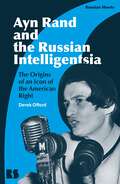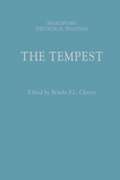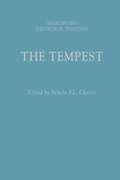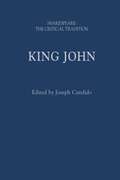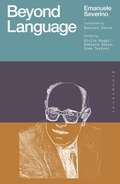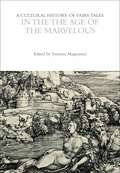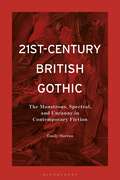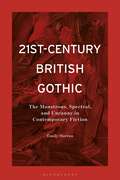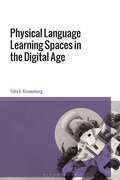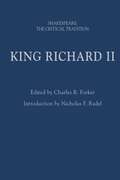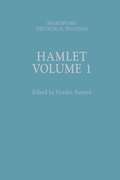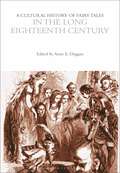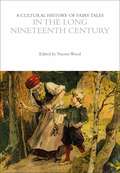- Table View
- List View
Ayn Rand and the Russian Intelligentsia: The Origins of an Icon of the American Right (Russian Shorts)
by Derek OffordThis book examines the writings of the American novelist Ayn Rand, especially The Fountainhead (1943) and Atlas Shrugged (1957), which Rand considered her definitive statement about the need for an unregulated free market in which superior humans could fully realize themselves by living for no-one but themselves. It explores Rand's conception of American identity, which exalted individualism and capitalism, and her solution for saving the modern American nation, which she believed was losing the spirit of its 18th- and 19th-century founders and frontiersmen, having been degraded morally and economically by the rampant socialism of the mid-20th-century world.Derek Offord crucially goes on to analyse how Rand's writings functioned as a vehicle in which she, a Russian-Jewish writer born in St Petersburg in 1905, engaged with ideas that had long animated the Russian intelligentsia. Her conception of human nature and of a utopian community capable of satisfying its needs; her reversal of conventional valuations of self-sacrifice and selfishness; her division of humans into an extraordinary minority and the ordinary mass; her comparison of competing civilizations – in all these areas, Offord argues that Rand drew on Russian debates and transposed them to a different context. Even the type of novel she writes, the novel of ideas, is informed by the polemical methods and habits of the Russian intelligentsia. The book concludes that her search for a brave new world continues to have topicality in the 21st century, with its populist critiques of liberal democracies and acrimonious debates about countries' moral, social, and economic priorities and their identities, inequalities, and social tensions.
The Tempest: Shakespeare: The Critical Tradition (Shakespeare: The Critical Tradition)
by Brinda CharryThe Tempest: Critical Tradition increases our knowledge of how Shakespeare's plays were received and understood by critics, editors and general readers. The volume offers, in separate sections, both critical opinions about the play across the centuries and an evaluation of their positions within and their impact on the reception of the play. The volume features criticism from key literary figures, such as Ben Jonson, Samuel Taylor Coleridge, John Dryden, John Ruskin and Edward Malone. The chronological arrangement of the text-excerpts engages the readers in a direct and unbiased dialogue, whereas the introduction offers a critical evaluation from a current stance, including modern theories and methods. Thus the volume makes a major contribution to our understanding of the play and of the traditions of Shakespearean criticism surrounding it as they have developed from century to century.
The Tempest: Shakespeare: The Critical Tradition (Shakespeare: The Critical Tradition)
The Tempest: Critical Tradition increases our knowledge of how Shakespeare's plays were received and understood by critics, editors and general readers. The volume offers, in separate sections, both critical opinions about the play across the centuries and an evaluation of their positions within and their impact on the reception of the play. The volume features criticism from key literary figures, such as Ben Jonson, Samuel Taylor Coleridge, John Dryden, John Ruskin and Edward Malone. The chronological arrangement of the text-excerpts engages the readers in a direct and unbiased dialogue, whereas the introduction offers a critical evaluation from a current stance, including modern theories and methods. Thus the volume makes a major contribution to our understanding of the play and of the traditions of Shakespearean criticism surrounding it as they have developed from century to century.
King John: Shakespeare: The Critical Tradition (Shakespeare: The Critical Tradition)
by Joseph CandidoThis new volume in Shakespeare: The Critical Tradition increases our knowledge of how Shakespeare's plays were received and understood by critics, editors and general readers. Updated with a new introduction providing a survey of critical responses to the plays since the late 1930s to the present day, the volume offers, in separate sections, both critical opinions about the play across the centuries and an evaluation of their positions within and their impact on the reception of the play. The chronological arrangement of the text-excerpts engages the readers in a direct and unbiased dialogue, whereas the introduction offers a critical evaluation from a current stance, including modern theories and methods. Thus the volume makes a major contribution to our understanding of the play and of the traditions of Shakespearean criticism surrounding it as they have developed from century to century.
King John: Shakespeare: The Critical Tradition (Shakespeare: The Critical Tradition)
This new volume in Shakespeare: The Critical Tradition increases our knowledge of how Shakespeare's plays were received and understood by critics, editors and general readers. Updated with a new introduction providing a survey of critical responses to the plays since the late 1930s to the present day, the volume offers, in separate sections, both critical opinions about the play across the centuries and an evaluation of their positions within and their impact on the reception of the play. The chronological arrangement of the text-excerpts engages the readers in a direct and unbiased dialogue, whereas the introduction offers a critical evaluation from a current stance, including modern theories and methods. Thus the volume makes a major contribution to our understanding of the play and of the traditions of Shakespearean criticism surrounding it as they have developed from century to century.
Beyond Language
by Emanuele SeverinoBeyond Language (Oltre il Linguaggio) is one of Italian philosopher Emmanuele Severino's major works, wrestling with whether it's possible to think meaningfully outside of the restrictions of language. Increasingly recognised as a truly foundational thinker in the formation of contemporary theory, Severino's ideas around self-expression, forms of communication and the limitations of language continue are brought to the fore in this book. Beyond Language specifically opens the door to the themes that Severino developed in his later works, including the concrete meaning of self-being and the decline of language. The depth and breadth of Severino's philosophical insight is as profound today as it was when first penned in 1992, making this first English translation of a key work in the history of continental philosophy crucial reading for those engaged with contemporary theory.
Beyond Language
by Emanuele SeverinoBeyond Language (Oltre il Linguaggio) is one of Italian philosopher Emmanuele Severino's major works, wrestling with whether it's possible to think meaningfully outside of the restrictions of language. Increasingly recognised as a truly foundational thinker in the formation of contemporary theory, Severino's ideas around self-expression, forms of communication and the limitations of language continue are brought to the fore in this book. Beyond Language specifically opens the door to the themes that Severino developed in his later works, including the concrete meaning of self-being and the decline of language. The depth and breadth of Severino's philosophical insight is as profound today as it was when first penned in 1992, making this first English translation of a key work in the history of continental philosophy crucial reading for those engaged with contemporary theory.
A Poetry Pedagogy for Teachers: Reorienting Classroom Literacy Practices
by Maya Pindyck Ruth Vinz Diana Liu Ashlynn WittchowA Poetry Pedagogy for Teachers generates imaginative encounters with poetry and invites educators to practice a range of poetry exercises in order to inform instructional approaches to reading and writing. Guided by pedagogical principles prompted by their readings of Wallace Stevens' “Thirteen Ways of Looking at a Blackbird,” Maya Pindyck and Ruth Vinz provide critical discussion of prominent literacy practices in secondary classrooms and offer alternative approaches to encountering a text. They do this by way of experimental readings of Wallace Stevens' poem toward a set of thirteen pedagogical principles that anchor a pedagogy of poetic practices. The book also offers invitational exercises, the authors' own engagements with poetry practices, as well as student examples, visual modes of theorizing, and a gathering of relevant resources compiled by two classroom teachers. This is a book for secondary English teachers, teaching artists, English educators, college writing professors, readers and writers of poetry – both existing and aspirational – and any educator interested in poetry's capacities to pedagogically inform their subject matter and/or literacy practices.
A Poetry Pedagogy for Teachers: Reorienting Classroom Literacy Practices
by Maya Pindyck Ruth Vinz Diana Liu Ashlynn WittchowA Poetry Pedagogy for Teachers generates imaginative encounters with poetry and invites educators to practice a range of poetry exercises in order to inform instructional approaches to reading and writing. Guided by pedagogical principles prompted by their readings of Wallace Stevens' “Thirteen Ways of Looking at a Blackbird,” Maya Pindyck and Ruth Vinz provide critical discussion of prominent literacy practices in secondary classrooms and offer alternative approaches to encountering a text. They do this by way of experimental readings of Wallace Stevens' poem toward a set of thirteen pedagogical principles that anchor a pedagogy of poetic practices. The book also offers invitational exercises, the authors' own engagements with poetry practices, as well as student examples, visual modes of theorizing, and a gathering of relevant resources compiled by two classroom teachers. This is a book for secondary English teachers, teaching artists, English educators, college writing professors, readers and writers of poetry – both existing and aspirational – and any educator interested in poetry's capacities to pedagogically inform their subject matter and/or literacy practices.
The Works of Graham Greene, Volume 3: Additions & Essays
Over a 60-year career, Graham Greene was a prolific and widely read writer. Completing a series of volumes which constitutes the only full bibliographical guide to Greene's published and unpublished writings, this book features updated listings of the scholarship associated with his work, details of recent audio and visual presentations and adaptations, as well as nine essays on lesser-known aspects of Greene's work.Featuring new material from the recently expanded Graham Greene archive which will be of particular interest and relevance to Greene scholars, it also covers contents of other archives in the UK and elsewhere in a series of mini-essays.
The Works of Graham Greene, Volume 3: Additions & Essays
by Jon Wise and Mike HillOver a 60-year career, Graham Greene was a prolific and widely read writer. Completing a series of volumes which constitutes the only full bibliographical guide to Greene's published and unpublished writings, this book features updated listings of the scholarship associated with his work, details of recent audio and visual presentations and adaptations, as well as nine essays on lesser-known aspects of Greene's work.Featuring new material from the recently expanded Graham Greene archive which will be of particular interest and relevance to Greene scholars, it also covers contents of other archives in the UK and elsewhere in a series of mini-essays.
A Cultural History of Fairy Tales in the Age of the Marvelous (The Cultural Histories Series)
by Suzanne MagnaniniHow have fairy tales from around the world changed over the centuries? What do they tell us about different cultures and societies?Drawing on the contributions of scholars working on Italian, French, English, Ottoman Turkish, and Japanese tale traditions, this book underscores the striking mobility and malleability of fairy tales written in the years 1450 to 1650. The essays examine how early modern scientific theories, debates on the efficacy of witchcraft, conceptions of race and gender, religious beliefs, the aesthetics of landscape, and censorial practices all shaped the representations of magic and marvels in the tales of this period.Tracing the fairy tale's swift movement across linguistic and geographic borders, through verse and prose versions, from the printed page to the early modern stage, this volume demonstrates the ways in which these fantastic literary texts explored the ideological borders constructed by different societies.An essential resource for researchers, scholars and students of literature, history and cultural studies, contributors explore themes including: forms of the marvelous, adaption, gender and sexuality, humans and non-humans, monsters and the monstrous, space, socialization, and power.A Cultural History of Fairy Tales (6-volume set)A Cultural History of Fairy Tales in Antiquity is also available as a part of a 6-volume set, A Cultural History of Fairy Tales, tracing fairy tales from antiquity to the present day, available in print, or within a fully-searchable digital library accessible through institutions by annual subscription or on perpetual access (see www.bloomsburyculturalhistory.com). Individual volumes for academics and researchers interested in specific historical periods are also available digitally via www.bloomsburycollections.com.
21st-Century British Gothic: The Monstrous, Spectral, and Uncanny in Contemporary Fiction
by Emily HortonIn this innovative re-casting of the genre and its received canon, Emily Horton explores fictional investments in the Gothic within contemporary British literature, revealing how such concepts as the monstrous, spectral and uncanny work to illuminate the insecure, uneven and precarious experience of 21st-century life. Reading contemporary works of Gothic fiction by Helen Oyeyemi, Kazuo Ishiguro, Sarah Moss, Patrick McGrath and M.R. Carey alongside writers not previously grouped under this umbrella, including Brian Chikwava, Chloe Aridjis and Mohsin Hamid, Horton illuminates the way the Gothic has been engaged and reread by contemporary writers to address the cultural anxieties invoked living under neocolonial and neoliberal governance, including terrorism, migration, homelessness, racism, and climate change. Marshalling new modes of diasporic and cross-disciplinary critical theory concerned with the violent dimensions of contemporary life, this book sets the Gothic aesthetics in such works as White is for Witching, Double Vision, Never Let Me Go, The Wasted Vigil and Ghost Wall against a backdrop of key events in the 21st-century. Drawing connections between moments of anxiety, such as 9/11, the wars in Afghanistan and Iraq, ecological disaster, the refugee crisis, Brexit, the pandemic, and the Gothic, Horton demonstrates how British literature mediates transnational experiences of trauma and horror, while also addressing local and national insecurities and preoccupations. As a result, 21st-Century British Gothic can tests geographical, psychological, cultural, and aesthetic borders to expose an often spectralised experience of human and planetary vulnerability and speaks back against the brutality of global capitalism.
21st-Century British Gothic: The Monstrous, Spectral, and Uncanny in Contemporary Fiction
by Emily HortonIn this innovative re-casting of the genre and its received canon, Emily Horton explores fictional investments in the Gothic within contemporary British literature, revealing how such concepts as the monstrous, spectral and uncanny work to illuminate the insecure, uneven and precarious experience of 21st-century life. Reading contemporary works of Gothic fiction by Helen Oyeyemi, Kazuo Ishiguro, Sarah Moss, Patrick McGrath and M.R. Carey alongside writers not previously grouped under this umbrella, including Brian Chikwava, Chloe Aridjis and Mohsin Hamid, Horton illuminates the way the Gothic has been engaged and reread by contemporary writers to address the cultural anxieties invoked living under neocolonial and neoliberal governance, including terrorism, migration, homelessness, racism, and climate change. Marshalling new modes of diasporic and cross-disciplinary critical theory concerned with the violent dimensions of contemporary life, this book sets the Gothic aesthetics in such works as White is for Witching, Double Vision, Never Let Me Go, The Wasted Vigil and Ghost Wall against a backdrop of key events in the 21st-century. Drawing connections between moments of anxiety, such as 9/11, the wars in Afghanistan and Iraq, ecological disaster, the refugee crisis, Brexit, the pandemic, and the Gothic, Horton demonstrates how British literature mediates transnational experiences of trauma and horror, while also addressing local and national insecurities and preoccupations. As a result, 21st-Century British Gothic can tests geographical, psychological, cultural, and aesthetic borders to expose an often spectralised experience of human and planetary vulnerability and speaks back against the brutality of global capitalism.
Conquered: The Last Children of Anglo-Saxon England
by Eleanor ParkerThe Norman Conquest is one of the most momentous events in English history and its consequences changed England forever. Indeed, the Battle of Hastings and its aftermath nearly wiped out the leading families of Anglo-Saxon England – so what happened to the children this conflict left behind?Conquered offers a fresh take on the Norman Conquest by exploring the lives of those children, who found themselves uprooted by the dramatic events of 1066. Among them were the children of Harold Godwineson and his brothers, survivors of a family shattered by violence who were led by their courageous grandmother Gytha to start again elsewhere. Then there were the last remaining heirs of the Anglo-Saxon royal line – Edgar Ætheling, Margaret, and Christina – who sought refuge in Scotland, where Margaret became a beloved queen and saint. Other survivors, such as Waltheof of Northumbria and Fenland hero Hereward, became legendary for rebelling against the Norman conquerors. And then there were some, like Eadmer of Canterbury, who chose to influence history by recording their own memories of the pre-conquest world.From sagas and saints' lives to chronicles and romances, Parker draws on a wide range of medieval sources to tell the stories of these young men and women and highlight the role they played in developing a new Anglo-Norman society. These tales – some reinterpreted and retold over the centuries, others carelessly forgotten over time – are ones of endurance, adaptation and vulnerability, and they all reveal a generation of young people who bravely navigated a changing world and shaped the country England was to become.
Conquered: The Last Children of Anglo-Saxon England
by Eleanor ParkerThe Norman Conquest is one of the most momentous events in English history and its consequences changed England forever. Indeed, the Battle of Hastings and its aftermath nearly wiped out the leading families of Anglo-Saxon England – so what happened to the children this conflict left behind?Conquered offers a fresh take on the Norman Conquest by exploring the lives of those children, who found themselves uprooted by the dramatic events of 1066. Among them were the children of Harold Godwineson and his brothers, survivors of a family shattered by violence who were led by their courageous grandmother Gytha to start again elsewhere. Then there were the last remaining heirs of the Anglo-Saxon royal line – Edgar Ætheling, Margaret, and Christina – who sought refuge in Scotland, where Margaret became a beloved queen and saint. Other survivors, such as Waltheof of Northumbria and Fenland hero Hereward, became legendary for rebelling against the Norman conquerors. And then there were some, like Eadmer of Canterbury, who chose to influence history by recording their own memories of the pre-conquest world.From sagas and saints' lives to chronicles and romances, Parker draws on a wide range of medieval sources to tell the stories of these young men and women and highlight the role they played in developing a new Anglo-Norman society. These tales – some reinterpreted and retold over the centuries, others carelessly forgotten over time – are ones of endurance, adaptation and vulnerability, and they all reveal a generation of young people who bravely navigated a changing world and shaped the country England was to become.
Physical Language Learning Spaces in the Digital Age
by Felix A. KronenbergHow do we intentionally design physical environments for language learning and teaching? How can we build spaces that are inclusive, accessible, safe and equitable? While the Covid-19 pandemic has advanced notions of online education, it has also revealed the benefits and affordances of human-to-human interaction in physical learning spaces. This book explores the design of physical spaces intended for language learning specifically.From residential learning spaces to active classrooms, from social and experiential spaces to zoom rooms and language centers, from mobile community-based learning to hybrid makerspaces, language learners and educators have more choices than ever regarding their possible learning environments. Changing pedagogies and new technologies provide ever more alternatives to the normalized technology of the classroom. With a focus on creating new awareness of the affordances and benefits of physical spaces as active agents in the language learning and teaching processes, this book takes a practical approach to introduce readers without any prior knowledge of design or architecture to the topic. As language learning spaces need to consider stakeholders from diverse cultures, Felix Kronenberg provides examples from language centers around the world, including Asia, Europe and the United States. Readers will learn how to conceptualize and create supportive, resilient, flexible, inclusive, accessible, affordable, sustainable, and safe physical learning spaces. The book is an interdisciplinary introduction to this emerging field, drawing from research in disciplines such as architecture, learning spaces design, second language acquisition, pedagogy, history, and sociology.
King Richard II: Shakespeare: The Critical Tradition (Shakespeare: The Critical Tradition)
by Nicholas F. RadelThis revised edition of King Richard II: Critical Tradition increases our the play was received and understood by critics, editors and general readers. Updated with a new introduction providing a survey of critical responses to Richard II since the 1990s to the present day, this volume offers, in separate sections, both critical opinions about the play across the centuries and an evaluation of their positions within and their impact on the reception of the play. The updated introduction offers an overview of recent criticism on the play in relation to feminist theory, queer theory, performance theory and ecocriticism. The chronological arrangement of the text-excerpts engages the readers in a direct and unbiased dialogue, whereas the introduction offers a critical evaluation from a current stance, including modern theories and methods. Featuring criticism by A.C. Swinburne, Walter Pater, Oscar Wilde and W.B. Yeats, this volume makes a major contribution to our understanding of the play and of the traditions of Shakespearean criticism surrounding it as they have developed from century to century.
King Richard II: Shakespeare: The Critical Tradition (Shakespeare: The Critical Tradition)
by Nicholas F. RadelThis revised edition of King Richard II: Critical Tradition increases our the play was received and understood by critics, editors and general readers. Updated with a new introduction providing a survey of critical responses to Richard II since the 1990s to the present day, this volume offers, in separate sections, both critical opinions about the play across the centuries and an evaluation of their positions within and their impact on the reception of the play. The updated introduction offers an overview of recent criticism on the play in relation to feminist theory, queer theory, performance theory and ecocriticism. The chronological arrangement of the text-excerpts engages the readers in a direct and unbiased dialogue, whereas the introduction offers a critical evaluation from a current stance, including modern theories and methods. Featuring criticism by A.C. Swinburne, Walter Pater, Oscar Wilde and W.B. Yeats, this volume makes a major contribution to our understanding of the play and of the traditions of Shakespearean criticism surrounding it as they have developed from century to century.
Hamlet: Shakespeare: The Critical Tradition, Volume 1 (Shakespeare: The Critical Tradition)
by Hardin AasandHamlet is one of Shakespeare's four great tragedies, studied and performed around the world. This new volume in Shakespeare: The Critical Tradition increases our knowledge of how Shakespeare's plays were received and understood by critics, editors and general readers. It traces the course of Hamlet criticism, from the earliest items of recorded criticism to the latter half of the Victorian period. The focus of the documentary material is from the late 18th century to the late 19th century. Thus the volume makes a major contribution to our understanding of the play and of the traditions of Shakespearean criticism surrounding it as they have developed from century to century. The introduction constitutes an important chapter of literary history, tracing the entire critical career of Hamlet from the beginnings to the present day.The volume features criticism from leading literary figures, such as Henry James, Anna Jameson, Victor Hugo, Thomas Carlyle, Samuel Taylor Coleridge and Mary Cowden Clarke. The chronological arrangement of the text-excerpts engages the readers in a direct and unbiased dialogue, whereas the introduction offers a critical evaluation from a current stance, including modern theories and methods. Thus the volume makes a major contribution to our understanding of the play and of the traditions of Shakespearean criticism surrounding it as they have developed from century to century.
Hamlet: Shakespeare: The Critical Tradition, Volume 1 (Shakespeare: The Critical Tradition)
Hamlet is one of Shakespeare's four great tragedies, studied and performed around the world. This new volume in Shakespeare: The Critical Tradition increases our knowledge of how Shakespeare's plays were received and understood by critics, editors and general readers. It traces the course of Hamlet criticism, from the earliest items of recorded criticism to the latter half of the Victorian period. The focus of the documentary material is from the late 18th century to the late 19th century. Thus the volume makes a major contribution to our understanding of the play and of the traditions of Shakespearean criticism surrounding it as they have developed from century to century. The introduction constitutes an important chapter of literary history, tracing the entire critical career of Hamlet from the beginnings to the present day.The volume features criticism from leading literary figures, such as Henry James, Anna Jameson, Victor Hugo, Thomas Carlyle, Samuel Taylor Coleridge and Mary Cowden Clarke. The chronological arrangement of the text-excerpts engages the readers in a direct and unbiased dialogue, whereas the introduction offers a critical evaluation from a current stance, including modern theories and methods. Thus the volume makes a major contribution to our understanding of the play and of the traditions of Shakespearean criticism surrounding it as they have developed from century to century.
Physical Language Learning Spaces in the Digital Age
by Felix A. KronenbergHow do we intentionally design physical environments for language learning and teaching? How can we build spaces that are inclusive, accessible, safe and equitable? While the Covid-19 pandemic has advanced notions of online education, it has also revealed the benefits and affordances of human-to-human interaction in physical learning spaces. This book explores the design of physical spaces intended for language learning specifically.From residential learning spaces to active classrooms, from social and experiential spaces to zoom rooms and language centers, from mobile community-based learning to hybrid makerspaces, language learners and educators have more choices than ever regarding their possible learning environments. Changing pedagogies and new technologies provide ever more alternatives to the normalized technology of the classroom. With a focus on creating new awareness of the affordances and benefits of physical spaces as active agents in the language learning and teaching processes, this book takes a practical approach to introduce readers without any prior knowledge of design or architecture to the topic. As language learning spaces need to consider stakeholders from diverse cultures, Felix Kronenberg provides examples from language centers around the world, including Asia, Europe and the United States. Readers will learn how to conceptualize and create supportive, resilient, flexible, inclusive, accessible, affordable, sustainable, and safe physical learning spaces. The book is an interdisciplinary introduction to this emerging field, drawing from research in disciplines such as architecture, learning spaces design, second language acquisition, pedagogy, history, and sociology.
A Cultural History of Fairy Tales in the Long Eighteenth Century (The Cultural Histories Series)
How have fairy tales from around the world changed over the centuries? What do they tell us about different cultures and societies?This volume traces the evolution of the genre over the period known as the long eighteenth century. It explores key developments including: the French fairy tale vogue of the 1690s, dominated by women authors including Marie-Catherine d'Aulnoy and Marie-Jeanne Lhéritier, the fashion of the oriental tale in the early eighteenth century, launched by Antoine Galland's seminal translation of The Thousand and One Nights from Arabic into French, and the birth of European children's literature in the second half of the eighteenth century. Drawing together contributions from an international range of scholars in history, literature and cultural studies, this volume examines the intersections between diverse national tale traditions through different critical perspectives, producing an authoritative transnational history of the genre. An essential resource for researchers, scholars and students of literature, history and cultural studies, this book explores such themes and topics as: forms of the marvelous, adaptation, gender and sexuality, humans and non-humans, monsters and the monstrous, spaces, socialization, and power.A Cultural History of Fairy Tales (6-volume set)A Cultural History of Fairy Tales in Antiquity is also available as a part of a 6-volume set, A Cultural History of Fairy Tales, tracing fairy tales from antiquity to the present day, available in print, or within a fully-searchable digital library accessible through institutions by annual subscription or on perpetual access (see www.bloomsburyculturalhistory.com). Individual volumes for academics and researchers interested in specific historical periods are also available digitally via www.bloomsburycollections.com.
A Cultural History of Fairy Tales in the Long Eighteenth Century (The Cultural Histories Series)
by Anne E. DugganHow have fairy tales from around the world changed over the centuries? What do they tell us about different cultures and societies?This volume traces the evolution of the genre over the period known as the long eighteenth century. It explores key developments including: the French fairy tale vogue of the 1690s, dominated by women authors including Marie-Catherine d'Aulnoy and Marie-Jeanne Lhéritier, the fashion of the oriental tale in the early eighteenth century, launched by Antoine Galland's seminal translation of The Thousand and One Nights from Arabic into French, and the birth of European children's literature in the second half of the eighteenth century. Drawing together contributions from an international range of scholars in history, literature and cultural studies, this volume examines the intersections between diverse national tale traditions through different critical perspectives, producing an authoritative transnational history of the genre. An essential resource for researchers, scholars and students of literature, history and cultural studies, this book explores such themes and topics as: forms of the marvelous, adaptation, gender and sexuality, humans and non-humans, monsters and the monstrous, spaces, socialization, and power.A Cultural History of Fairy Tales (6-volume set)A Cultural History of Fairy Tales in Antiquity is also available as a part of a 6-volume set, A Cultural History of Fairy Tales, tracing fairy tales from antiquity to the present day, available in print, or within a fully-searchable digital library accessible through institutions by annual subscription or on perpetual access (see www.bloomsburyculturalhistory.com). Individual volumes for academics and researchers interested in specific historical periods are also available digitally via www.bloomsburycollections.com.
A Cultural History of Fairy Tales in the Long Nineteenth Century (The Cultural Histories Series)
by Naomi J. WoodHow have fairy tales from around the world changed over the centuries? What do they tell us about different cultures and societies?This volume explores the period when the European fairy tales conquered the world and shaped the global imagination in its own image. Examining how collectors, children's writers, poets, and artists seized the form to challenge convention and normative ideas, this book explores the fantastic imagination that belies the nineteenth century's materialist and pedestrian reputation. Looking at writers including E.T.A Hoffman, the Brothers Grim, S.T. Coleridge, Walter Scott, Oscar Wilde, Christina Rosetti, George MacDonald, and E. Nesbit, the volume shows how fairy tales touched every aspect of nineteenth century life and thought. It provides new insights into themes including: forms of the marvelous, adaptation, gender and sexuality, humans and non-humans, monsters and the monstrous, spaces, socialization, and power. With contributions from international scholars across disciplines, this volume is an essential resource for researchers, scholars and students of literature, history, and cultural studies.A Cultural History of Fairy Tales (6-volume set)A Cultural History of Fairy Tales in Antiquity is also available as a part of a 6-volume set, A Cultural History of Fairy Tales, tracing fairy tales from antiquity to the present day, available in print, or within a fully-searchable digital library accessible through institutions by annual subscription or on perpetual access (see www.bloomsburyculturalhistory.com). Individual volumes for academics and researchers interested in specific historical periods are also available digitally via www.bloomsburycollections.com.
